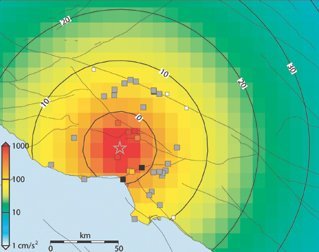Quick quake alerts
A system of detectors could provide a few seconds warning that an earthquake is coming.
By Emily Sohn
The ground shakes. Dishes fall off shelves. Houses collapse. Cars topple over bridges. Every year, earthquakes destroy homes and schools, and they kill many thousands of people around the world. Even scarier, it’s impossible to know exactly when and where the next one will strike.

Earthquakes cause a few different kinds of underground vibrations. One kind are called P waves, which travel quickly through Earth and rarely cause damage. The S waves that follow are more dangerous. They travel half as fast and shake the ground from side to side.
Richard M. Allen of the University of Wisconsin-Madison and his colleagues analyzed ground motions from 53 fairly strong earthquakes that have struck Los Angeles since 1995. By looking at the first few seconds of a quake’s P wave, they found they could predict how big the oncoming S wave would be.
Using detectors already in place throughout Los Angeles could give residents at least a few seconds warning that a quake is coming, Allen suggests. That wouldn’t be enough time to run away. But a siren or Internet message could save lives by giving people time to shut off power and stop trains. Kids in school could dive under their desks.
The system wouldn’t make earthquakes any less scary, but at least you’d know what was coming.







